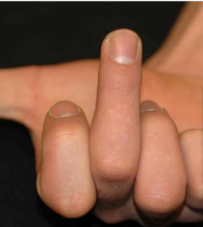
Lumbrical Plus Finger is an uncommon condition where the finger IP joints extend paradoxically when trying to flex the fingers into a fist. It typically affects the middle finger and is caused by disruption of the flexor digitorum profundus (FDP) tendon.
What Happens in Lumbrical Plus Finger?
The lumbricals are small muscles in the hand that originate from the FDP and insert onto the extensor hood on the sides of the fingers. When the FDP is cut or avulsed, the lumbricals pull on the extensor hood when the FDP contracts, causing the IP joints to extend.
This happens most often in the middle finger because the FDP to the middle and ring fingers share a common muscle belly. If the FDP is cut in the middle finger, it gets pulled ulnarly by the ring finger lumbrical, tightening the middle finger lumbrical and amplifying the paradoxical motion.
Who Gets Lumbrical Plus Finger?
People who sustain a volar laceration across the FDP or an avulsion injury from sudden axial traction on a flexed digit can develop lumbrical plus finger. It is diagnosed when a patient has IP joint extension of one digit when trying to make a fist.
How is Lumbrical Plus Finger Treated?
Mild cases can be observed, but surgical treatment is often required for symptomatic patients to restore normal finger flexion. Options include:
- Tenodesis of FDP to the distal phalanx
- Lumbrical release at the base of the flexor sheath
Releasing the lumbrical is generally avoided in acute injuries until it is clear paradoxical motion will persist. Proper hand therapy is essential after surgery to prevent adhesion formation and stiffness.
References:
Schuind FA, Moungondo F, Van Wetter P. A New Clinical Sign of Lumbrical Plus Finger. J Hand Surg Am. 2018 Jun;43(6):573.e1-573.e4. doi: 10.1016/j.jhsa.2017.10.040. Epub 2017 Dec 6. PMID: 29223629.
Lumbrical Plus Finger. Orthobullets. (n.d.). https://www.orthobullets.com/hand/6017/lumbrical-plus-finger

